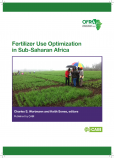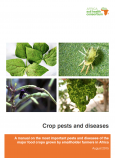Rwanda
Optimizing Fertilizer & ISFM in Rwanda
- Summary:
Optimizing Fertilizer Use within the Context of Integrated Soil Fertility Management in Rwanda is chapter 13 of the OFRA publication - Fertilizer use optimization in sub-Saharan Africa
- Languages:
- English

Rwanda ISFM-soil test decision table
- Summary:
The decision table works with the fertilizer optimisation tool to support farmers with fertilizer investment decisions.
- Languages:
- English
Identified soyabean, common bean, cowpea and groundnut varieties with high Biological Nitrogen Fixation potential identified in N2Africa impact zones
- Summary:
Part 1: Is an overview of the methodology used by N2A to estimate BNF by evaluated legume varieties, the criteria used by farmers to select legume varieties and their preferred varieties in different impact zones. It also present results from literature to estimate the values of parameters necessary to assess BNF in legumes.
Part 2: Presents lists of legume varieties found to be high in BNF potential across different impact zones and discuss their potential acceptability by farmers in the N2A Impact Zones.
- Languages:
- English
Crop pests & diseases affecting African smallholders – manual
- Summary:
This manual provides clear, actionable information on the most important pests and diseases that affect the major food crops grown by smallholder farmers in Africa. Crops covered are: cereals (maize, millet, sorghum, rice), legumes (groundnuts, beans and cowpeas) roots and tubers (cassava, sweet potato, yam) and banana.
For each pest or disease, information is provided on how to recognise the problem, what to do to prevent it occurring and how to control it when it occurs. The management options for each pest or disease are divided into ‘cultural approaches’, such as use of resistant varieties, clean seed, crop rotations and good hygiene in the field, and ‘chemical approaches’, which involve the use of appropriate pesticides. In addition information is provided on the organism that causes the problem and its impact. Finally, a short list of publications and websites is given where additional information can be obtained.
A team of plant health experts has compiled this information; in doing so they have drawn upon the latest research and information available in 2015.
- Languages:
- English

OFRA data entry protocol
- Summary:
Manual to support data entry into the OFRA shared database which is used as the basis of producing fertilizer optimisation tools.
- Languages:
- English

Pest factsheet: Larger grain borer
- Summary:
This guide sets out the causes, impact, signs and symptoms of larger grain borer and offers practical advice on management through prevention and control strategies.
- Languages:
- English, Swahili / Kiswahili
Pest factsheet: Maize lethal necrosis disease
- Summary:
This guide sets out the causes, impact, signs and symptoms of maize lethal necrosis disease and offers practical advice on management through prevention and control strategies.
- Languages:
- English, Swahili / Kiswahili
Pest factsheet: Cassava bacterial blight
- Summary:
This guide sets out the causes, impact, signs and symptoms of cassava bacterial blight and offers practical advice on management through prevention and control strategies.
- Languages:
- English, Swahili / Kiswahili
